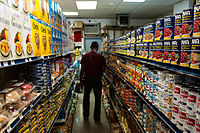
Photo from wikipedia
A recent policy in the U.S. authorized monthly benefits from a nutrition assistance program - Supplemental Nutrition Assistance Program (SNAP) - to be used online to increase grocery access and… Click to show full abstract
A recent policy in the U.S. authorized monthly benefits from a nutrition assistance program - Supplemental Nutrition Assistance Program (SNAP) - to be used online to increase grocery access and promote healthy eating. This study examined online grocery attitudes and purchasing behaviors among low-income SNAP-eligible households with young children with and without online grocery experience. An explanatory mixed methods design was used, including a survey informed by the theory of planned behavior (TPB) and focus groups conducted between November-March 2021. In the quantitative phase, 310 Maryland residents completed an online survey assessing TPB constructs (attitudes, social norms, perceived control), and food purchase frequency online and in-store. Subsequently, 42 participated in the qualitative phase. Differences in TPB constructs and food purchases were compared between families with and without online grocery experience. Online food selection and fees were a common obstacle to online grocery purchasing. Families who had purchased groceries online (57%) had more positive attitudes and perceived fewer barriers to online shopping than those who had not. Self-reported frequency of buying fresh produce (OR = 0.34, p < 0.001), meat and seafood (OR = 0.29, p < 0.001), and sweets (OR = 0.54, p = 0.005) were lower online than in-store. Families discussed mistrust of online hired shoppers and fewer impulse purchases online as reasons for less frequent purchases of produce and sweets, respectively. Successful scale-up of the U.S. policy must address barriers to healthier purchasing behaviors to effectively promote equitable food access, such as decreasing delivery fees and improving the online food selection.
Journal Title: Appetite
Year Published: 2022
Link to full text (if available)
Share on Social Media: Sign Up to like & get
recommendations!